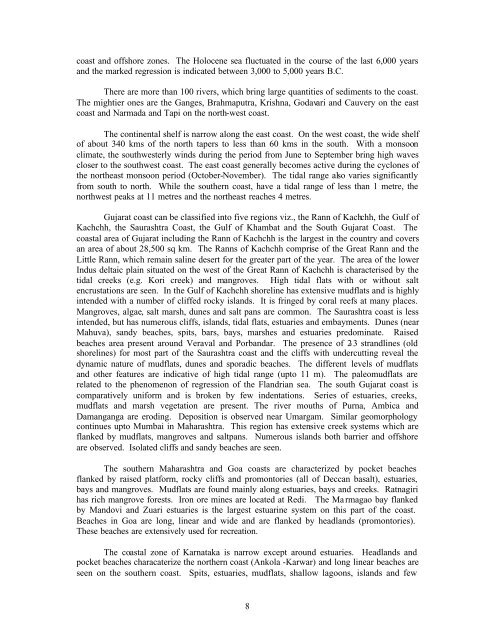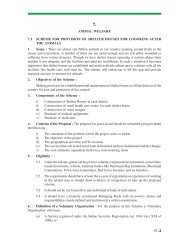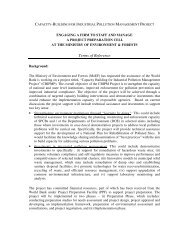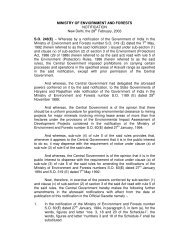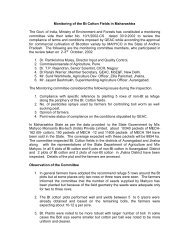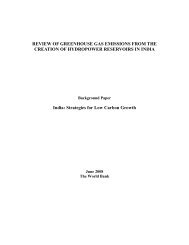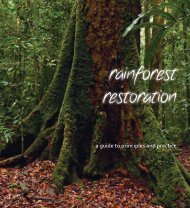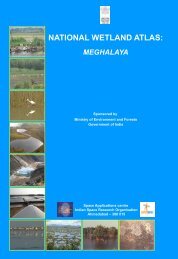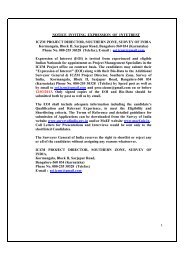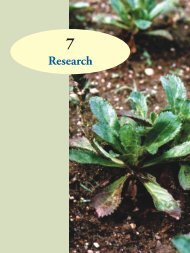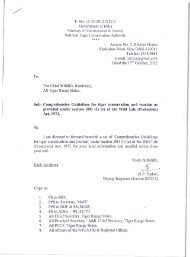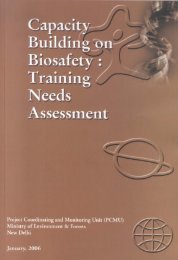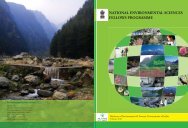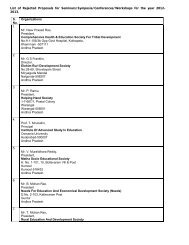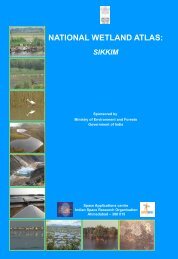pdf - Ministry of Environment and Forests
pdf - Ministry of Environment and Forests
pdf - Ministry of Environment and Forests
- TAGS
- ministry
- forests
- moef.nic.in
You also want an ePaper? Increase the reach of your titles
YUMPU automatically turns print PDFs into web optimized ePapers that Google loves.
coast <strong>and</strong> <strong>of</strong>fshore zones. The Holocene sea fluctuated in the course <strong>of</strong> the last 6,000 years<br />
<strong>and</strong> the marked regression is indicated between 3,000 to 5,000 years B.C.<br />
There are more than 100 rivers, which bring large quantities <strong>of</strong> sediments to the coast.<br />
The mightier ones are the Ganges, Brahmaputra, Krishna, Godavari <strong>and</strong> Cauvery on the east<br />
coast <strong>and</strong> Narmada <strong>and</strong> Tapi on the north-west coast.<br />
The continental shelf is narrow along the east coast. On the west coast, the wide shelf<br />
<strong>of</strong> about 340 kms <strong>of</strong> the north tapers to less than 60 kms in the south. With a monsoon<br />
climate, the southwesterly winds during the period from June to September bring high waves<br />
closer to the southwest coast. The east coast generally becomes active during the cyclones <strong>of</strong><br />
the northeast monsoon period (October-November). The tidal range also varies significantly<br />
from south to north. While the southern coast, have a tidal range <strong>of</strong> less than 1 metre, the<br />
northwest peaks at 11 metres <strong>and</strong> the northeast reaches 4 metres.<br />
Gujarat coast can be classified into five regions viz., the Rann <strong>of</strong> Kachchh, the Gulf <strong>of</strong><br />
Kachchh, the Saurashtra Coast, the Gulf <strong>of</strong> Khambat <strong>and</strong> the South Gujarat Coast. The<br />
coastal area <strong>of</strong> Gujarat including the Rann <strong>of</strong> Kachchh is the largest in the country <strong>and</strong> covers<br />
an area <strong>of</strong> about 28,500 sq km. The Ranns <strong>of</strong> Kachchh comprise <strong>of</strong> the Great Rann <strong>and</strong> the<br />
Little Rann, which remain saline desert for the greater part <strong>of</strong> the year. The area <strong>of</strong> the lower<br />
Indus deltaic plain situated on the west <strong>of</strong> the Great Rann <strong>of</strong> Kachchh is characterised by the<br />
tidal creeks (e.g. Kori creek) <strong>and</strong> mangroves. High tidal flats with or without salt<br />
encrustations are seen. In the Gulf <strong>of</strong> Kachchh shoreline has extensive mudflats <strong>and</strong> is highly<br />
intended with a number <strong>of</strong> cliffed rocky isl<strong>and</strong>s. It is fringed by coral reefs at many places.<br />
Mangroves, algae, salt marsh, dunes <strong>and</strong> salt pans are common. The Saurashtra coast is less<br />
intended, but has numerous cliffs, isl<strong>and</strong>s, tidal flats, estuaries <strong>and</strong> embayments. Dunes (near<br />
Mahuva), s<strong>and</strong>y beaches, spits, bars, bays, marshes <strong>and</strong> estuaries predominate. Raised<br />
beaches area present around Veraval <strong>and</strong> Porb<strong>and</strong>ar. The presence <strong>of</strong> 2-3 str<strong>and</strong>lines (old<br />
shorelines) for most part <strong>of</strong> the Saurashtra coast <strong>and</strong> the cliffs with undercutting reveal the<br />
dynamic nature <strong>of</strong> mudflats, dunes <strong>and</strong> sporadic beaches. The different levels <strong>of</strong> mudflats<br />
<strong>and</strong> other features are indicative <strong>of</strong> high tidal range (upto 11 m). The paleomudflats are<br />
related to the phenomenon <strong>of</strong> regression <strong>of</strong> the Fl<strong>and</strong>rian sea. The south Gujarat coast is<br />
comparatively uniform <strong>and</strong> is broken by few indentations. Series <strong>of</strong> estuaries, creeks,<br />
mudflats <strong>and</strong> marsh vegetation are present. The river mouths <strong>of</strong> Purna, Ambica <strong>and</strong><br />
Damanganga are eroding. Deposition is observed near Umargam. Similar geomorphology<br />
continues upto Mumbai in Maharashtra. This region has extensive creek systems which are<br />
flanked by mudflats, mangroves <strong>and</strong> saltpans. Numerous isl<strong>and</strong>s both barrier <strong>and</strong> <strong>of</strong>fshore<br />
are observed. Isolated cliffs <strong>and</strong> s<strong>and</strong>y beaches are seen.<br />
The southern Maharashtra <strong>and</strong> Goa coasts are characterized by pocket beaches<br />
flanked by raised platform, rocky cliffs <strong>and</strong> promontories (all <strong>of</strong> Deccan basalt), estuaries,<br />
bays <strong>and</strong> mangroves. Mudflats are found mainly along estuaries, bays <strong>and</strong> creeks. Ratnagiri<br />
has rich mangrove forests. Iron ore mines are located at Redi. The Ma rmagao bay flanked<br />
by M<strong>and</strong>ovi <strong>and</strong> Zuari estuaries is the largest estuarine system on this part <strong>of</strong> the coast.<br />
Beaches in Goa are long, linear <strong>and</strong> wide <strong>and</strong> are flanked by headl<strong>and</strong>s (promontories).<br />
These beaches are extensively used for recreation.<br />
The coastal zone <strong>of</strong> Karnataka is narrow except around estuaries. Headl<strong>and</strong>s <strong>and</strong><br />
pocket beaches characaterize the northern coast (Ankola -Karwar) <strong>and</strong> long linear beaches are<br />
seen on the southern coast. Spits, estuaries, mudflats, shallow lagoons, isl<strong>and</strong>s <strong>and</strong> few<br />
8


